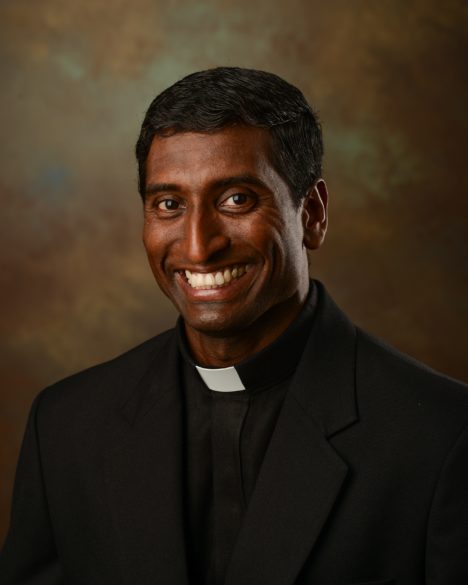
Mary Woodward, Chancellor Diocese of Jackson
Mary Woodward, Chancellor Diocese of JacksonFrom the Archives
By Mary Woodward
JACKSON – For those of you who knew Bishop William Houck, you know he was a larger-than-life persona. His booming voice and laughter were recognizable before he ever entered the room. He was a great man of the church and never missed a chance to evangelize others through word and deed.
Bishop Houck clung to traditions and for every holiday he had one. We always knew which holidays were spent with whom and what time he would head to Mobile for family celebrations. He adored his family, and they looked forward to his visits with great joy.
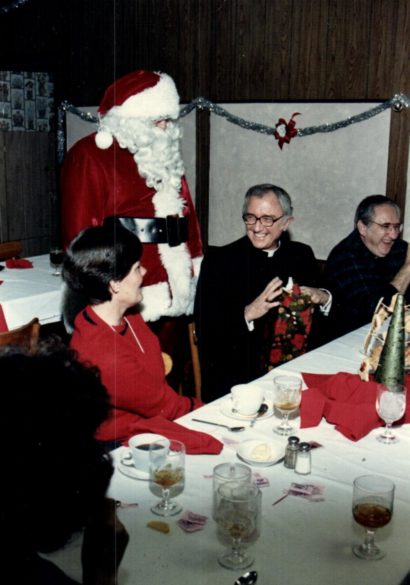
At Christmas, Bishop Houck loved for his residence to be decorated with lights, angels, poinsettias, wreaths and any Christmas merriment that could be found in his vast collection. He had an outdoor nativity set given to him by Virginia McCaskey, owner of the Chicago Bears. For this festive ensemble, he had a local craftsman build a stable that could be disassembled and stored in the garage after Epiphany. It was my task to meet the craftsman each year to retrieve the stable from the garage rafters, set out the holy family, and plug up the lights; then meet him again to take it all down while Bishop Houck was on the annual region V bishops’ retreat.
Another annual tradition was getting the live Christmas tree for his house. Bishop Houck did not like artificial trees. I still remember the look on his face when someone suggested he get one. Yikes for that person!
Jim McCraw, Knight of Columbus extraordinaire, was the man with the truck who was called upon each year to go with Bishop Houck to get the perfect tree. Keeping with his tradition, Bishop liked to wait until closer to Christmas to get the tree. I remember one year he waited a little too late and the lot where they normally got the tree had been abandoned. Fortunately, the trees that didn’t sell were left behind as well, so that year the evergreen was a little dry but gratis.
McCraw was reminiscing about tree shopping a few weeks ago and sent me the following account of the yuletide expedition.
“Right about now I’d be getting a call from the bishop wanting to go tree shopping. I looked forward to it every year and always enjoyed his stories about his dad taking him to get their tree as a child. After getting it in the house, his mother would make him go outside and look through the window to make sure it was straight.
“Bishop would look all the trees over until he found the perfect one. You knew when he found it because he’d explode in energy: ‘THIS IS IT!’ He talked to everyone – a true man of the people.
“After getting the tree inside and in place my final task was to put the bowl of water under it. I’d offer to do the lights, but he always said: ‘No Jim, I leave all that to Mary Woodward.’ (Author’s note: I would have been fine if Jim had put the lights on the tree, but it was Bishop’s tradition, and I was blessed to be a part of it.)
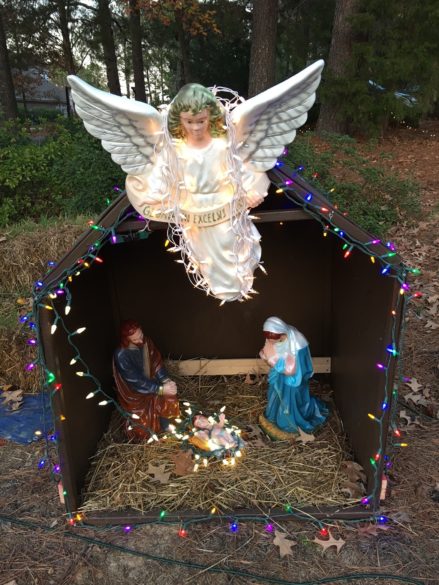
“One of our early trips had us looking for Christmas tree lots in northeast Jackson. We ended up driving past the Gray-Lewis house with the kids playing outside. They waved so he wanted to stop. “Vic and Geri had a neighbor who was in her final hours, and they asked if Bishop would give her a blessing. Out he went … they told him she didn’t speak English. ‘Fine, Fine’ he said in his booming voice.
“As he got back in the truck, in his non-clerical tree-shopping attire, the youngest Gray-Lewis child asked: ‘Are you really the bishop?’ You can imagine his laughter. Made his day.
“I asked him about the language barrier, and he said: ‘It’s not what you say, it’s that you’re there, Jim.’ Great man. I do miss him.”
I miss him too. He was an imparter of great wisdom and a wonderful mentor to so many. The memories of his traditions will live on in my heart, Jim’s heart, and especially the hearts of his family.
Whether you open presents on Christmas Eve or Christmas Day; whether you go to the family Mass at 4:30 p.m., Midnight Mass, or Mass on Christmas Day; whether you eat turkey, ham or tofu; may you all have a very Merry Christmas where you joyfully celebrate your own cherished traditions and maybe create a few new ones. Take time to remember those who have gone on to the Lord (as Bishop Houck would say) and thank God for placing them in your path.
Christus natus est!
From the Archives
By Mary Woodward
JACKSON – Travelling statues is once again the topic of our archives journey.
This past weekend I was in Greenwood at Immaculate Heart of Mary parish for the celebration of Confirmation with Bishop Joseph Kopacz. As you may recall, IHM sadly was vandalized back in January and their beloved statue of the Blessed Mother was severely damaged.
We were able to restore the statue through the gifted hands of Eyd Kazery and return her to the parish in time for the feast of the Immaculate Heart of Mary in June.
This past Sunday for the first time I was able to see her in person adorning her newly designed place of honor in the church. Joy welled up in my heart to see her standing there watching over the congregation.
For centuries statues have adorned churches and churchyards reflecting images of our Catholic faith family. When people ask me why Catholics pray to statues, I respond by asking them if they have photos of their parents and grandparents somewhere such as the staircase wall.
I go on to explain that our statues and images of saints are similar to their family photos. The images invoke reverence for people who have inspired us, and we believe in faith to be in heaven available to offer prayers on our behalf to God. That usually does the trick and in answering the question an act of evangelization has just occurred.
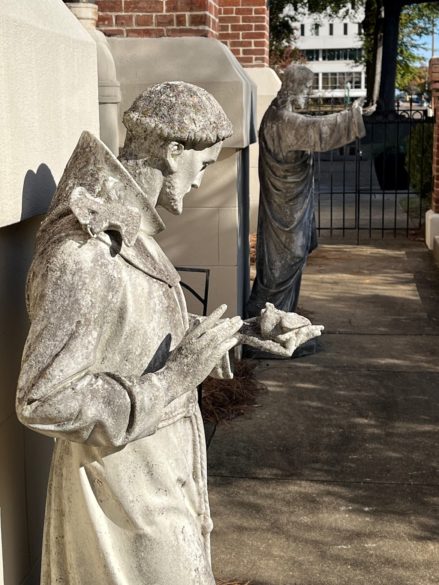
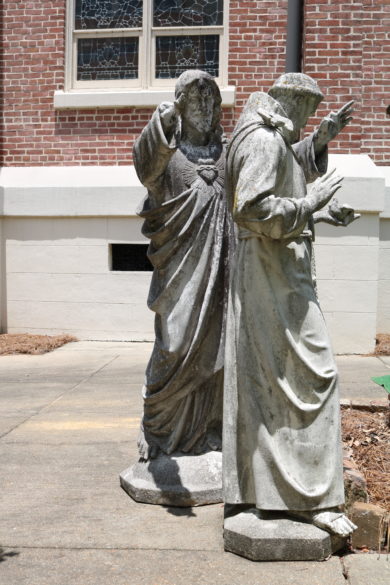
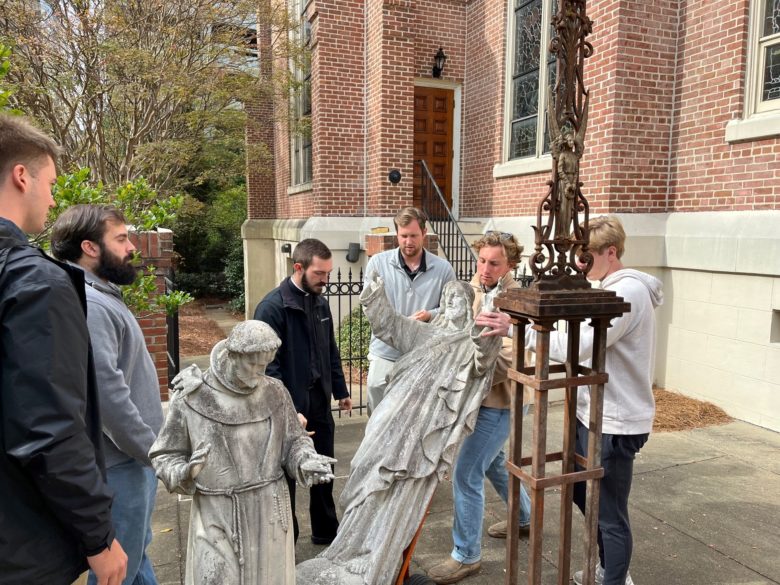
JACKSON – Diocesan seminarian and some strong Belhaven University students were able to move the Sacred Heart of Jesus and St. Francis statues in the Bishop’s Cemetery next to the Cathedral of St. Peter the Apostle. (Photos courtesy of Mary Woodward)
Statues at the Cathedral took center stage as tools of evangelization the week of Thanksgiving.
Last year two statues in the Bishop’s Cemetery had to be moved to prepare the grave for Bishop Joseph N. Latino. Those two statues – the Sacred Heart of Jesus and St. Francis – never got moved back. We had left them in place not only because the Sacred Heart looked as if it were consoling St. Francis and that is a very appropriate scene in a cemetery, but also because they weigh about 400 – 500 lbs. each.
Herein lies the evangelization moment. We have a Belhaven University baseball player named Luke from Lake Charles, Louisiana, who serves at the 10:30 Mass on Sunday at the Cathedral. He loves his Catholic faith and remarked to me one Sunday in the sacristy that there were several other Catholic players on the team who did not always make it to Mass.
Remembering the misplaced statues, I suggested perhaps we could get them interested in coming to Mass if we had some kind of service project such as moving the statues. Luke took this to heart and the Monday before Thanksgiving he showed up for the daily noon Mass at the Cathedral with several teammates.
It just so happened several of our diocesan seminarians were at Mass and just like that we had 10 strapping young men to move those two statues. Indeed, it was a Holy Spirit moment.
The bonus was we wanted the statues placed in different spots from their previous locales and the young men were so very amenable to wrangling them some 20-25 feet from where they were.
The Sacred Heart statue was first to move. He was the heavier of the two and he was too heavy for the dolly. So, they basically walked the statue into its place along the side wall of the Cathedral. At times it looked like a dance and at other times a wrestling match, but mission accomplished.
St. Francis was lighter and easily moved on the dolly to his spot overlooking the bishops’ burial plots with the Sacred Heart. Passersby may now see both statues more easily and hopefully be inspired to offer prayers for our deceased bishops.
After the project was complete, our seminarians invited the teammates into the Cathedral where I gave them an expedited tour of the stained-glass windows and sanctuary along with a little history of the diocese before they headed back to campus. A couple of the baseball players were so enthusiastic they volunteered to come back and move things whenever we needed help.
Mission accomplished. We had connected them to a parish, and they want to come back and be a part.
Evangelization 101 – invite people to church. We know the Lord uses us in creative ways to bring people closer to him. You never know who is seeking the Lord and may be inspired by your sincere invitation.
FROM THE ARCHIVES
By Mary Woodward
JACKSON – Once again, we come to the great feast of Thanksgiving throughout our country. Looking back over the years I would like to share some moments at table in the presence of cherished friends, some of whom have gone on to the Lord where they will partake in the feast of Thanksgiving for all eternity.
When we gather around the table with friends and family, we are sharing in communion with one another. I like to think all of our ancestors and dear ones, who made contributions to our lives great and small, are gathered there with us forming a communion of saints.
The Thanksgiving holiday offers a time for us to reflect on those ancestors and dear ones – to enjoy those present physically and those who are there transcending the moment in our memories. It is a time to be thankful for the moments we have shared and continue to share with those who love us and those whom we love.
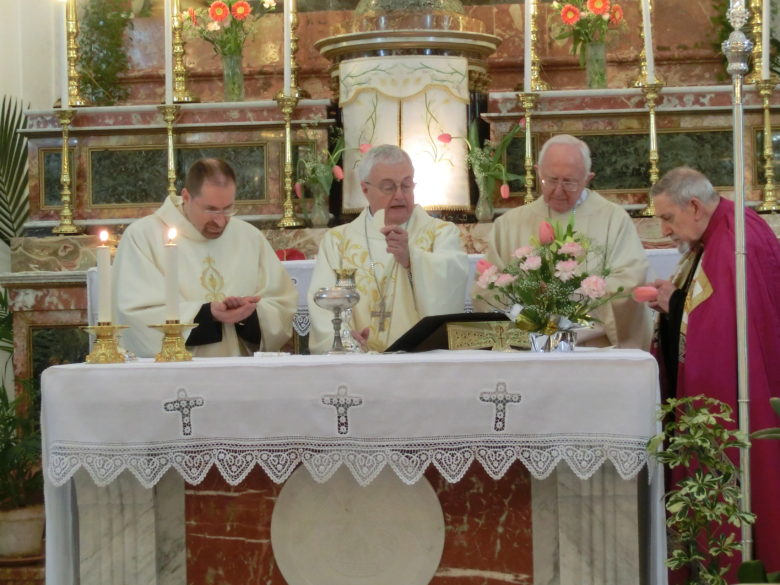
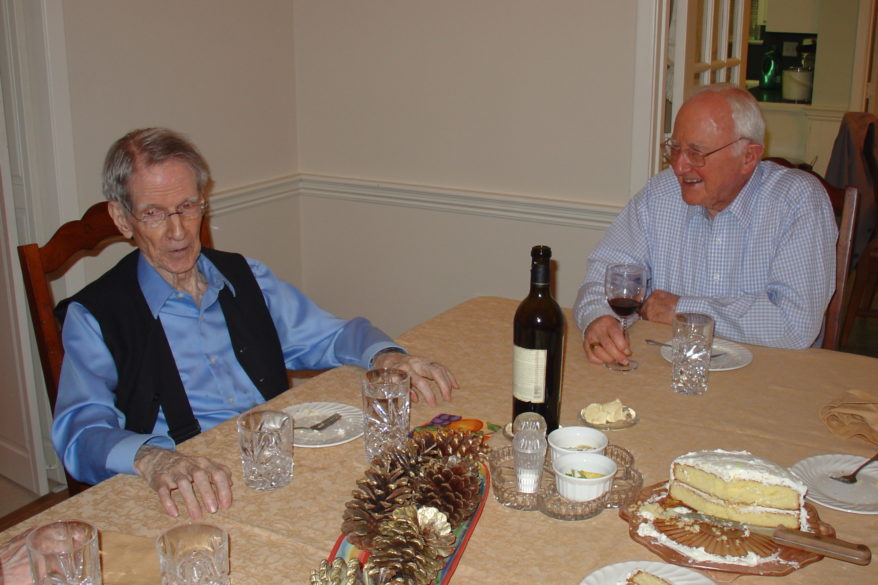
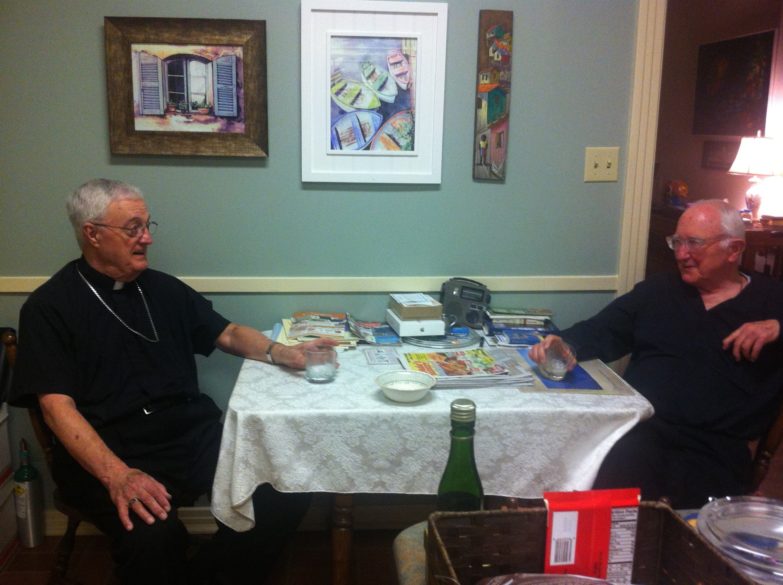
Pictured are gatherings around tables around the diocese over the years. The word Eucharist means “thanksgiving,” so gathering around the altar for the celebration of the Eucharist is the most profound gathering of all gatherings. (Photos courtesy of archives)
And of course, the ultimate table for us to gather around is the altar where we share in the heavenly banquet with the entire communion of saints. The word Eucharist means thanksgiving, so gathering around the altar for the celebration of the Eucharist is the most profound gathering of all gatherings.
This Thanksgiving I hope we all are able to ponder the many blessings we have in our lives even if they are small. Take the time to let your friends and family know exactly how much they mean to you and what a blessing they are in your life.
Spend time in prayer for those who do not have family and friends available to them or are in strained family situations. Do not miss an opportunity to heal a rift and mend a heart by showing kindness, patience and love. You do not want to have regrets when that person is gone.
Most of all, give thanks to God for bestowing the grace, mercy and peace upon you that can only come from encountering and surrendering to God’s infinite heart. Take care of one another.
(Mary Woodward is Chancellor and Archivist for the Diocese of Jackson.)
From the Archives
By Mary Woodward
JACKSON – Cemeteries are fantastic, visual archives. The history of a community, a church, a family is literally written in stone. In a few short phrases, a person’s life is summed up: “Devoted Mother,” “Beloved Son,” “Christian, Southern Gentleman,” “Faithful Wife.” Often it is a favorite scripture verse such as John 3:16 or a favorite poetry line such as “horseman pass by.”
Servant of God Sister Thea Bowman, FSPA, asked that the words “she tried” be on her tombstone. William Faulkner has “Belove’d Go with God” on his marker. One poignant one I have seen is “In the end it all comes down to one word, Grace.” And we all have that person in our family who warrants the “I told you I was sick” epitaph. As Catholics, we like to see R.I.P. on a grave for requiescat in pace or rest in peace.
Currently, the chancellor’s office is assisting in an inventory of Catholic cemeteries in the diocese. We have a listing of all the parish connected cemeteries, but often when a chapel or mission church closed decades ago, small cemeteries can be left off of the registry. We welcome any information on these locations.
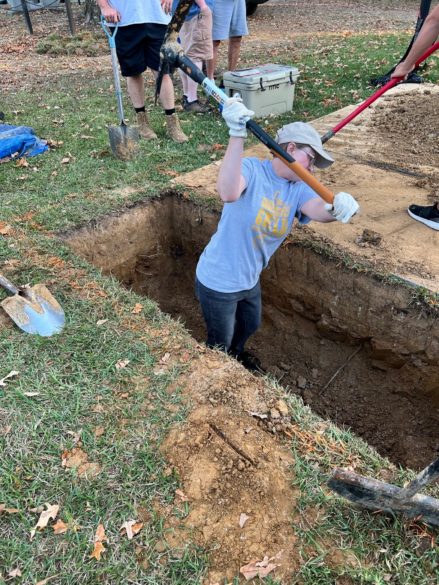
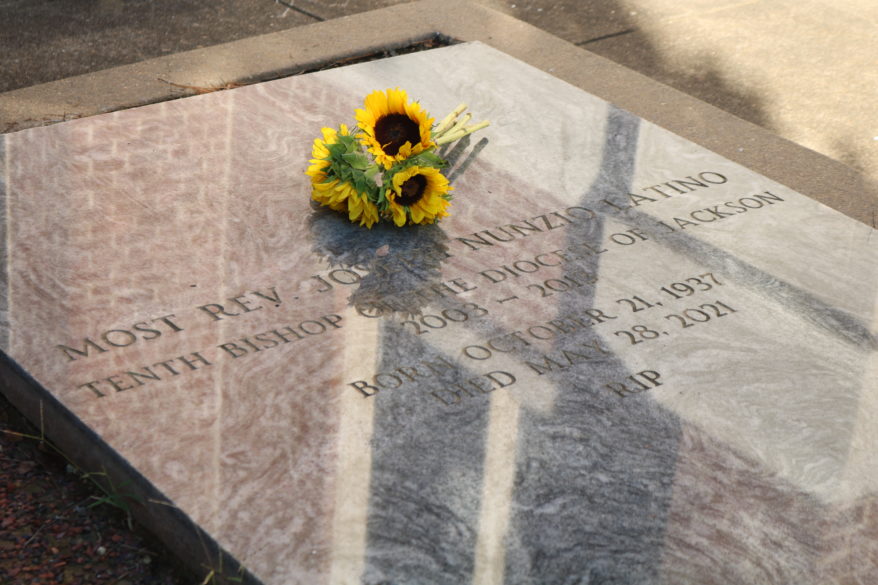
JACKSON – Mary Woodward uses a pickaxe to assist in digging a grave at Chapel of the Cross Episcopal Church in Madison County. On left, Woodward left Bishop Joseph Latino’s favorite flower on his gravesite in the Bishops’ Cemetery next to the Cathedral of St. Peter the Apostle in Jackson. (Photos courtesy of Mary Woodward and Joanna Puddister King)
In our diocese, we have several Catholic cemeteries dating back to the early 1800s. Paulding St. Michael, the second oldest parish in the entire state, has a beautiful cemetery filled with founding family members. There is a forest of bamboo standing 30-feet high that surrounds much of the back of the cemetery. Not long ago, St. Michael parishioners with the advice of Mississippi State’s Extension Service invested in a barrier to keep the bamboo from spreading farther into graves. They also built a fence around the graveyard to keep the occasional nocturnal burial from occurring as can happen in small country cemeteries.
It is fitting we are doing this during the month of November. November is the month to remember the dead in our Catholic faith. It opens with the Solemnity of All Saints where we honor all those ordinary people in our lives who were saints to us. The next day is All Souls in which we honor the dead and, in many traditions, decorate graves and have picnics in cemeteries.
The Bishops’ Cemetery on the Cathedral grounds is right across the street from the Chancery. Each year we place flowers on the graves of Bishops Richard Gerow, Joseph Brunini, William Houck and Joseph Latino. This year, as we positioned the roses and sunflowers, I was able to reflect on these men and the act of assisting in burying three of the four.
Because of the location and design of the Bishops’ Cemetery, the graves are hand dug. This is a very arduous task which takes a team of gravediggers many hours to complete.
Burying the dead is a corporal work of mercy and we all have in some way participated in burying the dead by planning funerals, being present for the family, celebrating the funeral Mass, bringing food to the repast. But actually digging the grave with a shovel and pickaxe is a profound way to fully immerse oneself in the act of mercy.
Recently, I participated in two such acts. My brother is head of the gravedigger’s guild at Chapel of the Cross Episcopal Church in Madison County. He invited me to join in for a dig in August and then again last week.
The cemetery at the Chapel dates back to the mid-1800s and is on a serene piece of property off Hwy 463. The congregation has never allowed equipment onto the property to dig graves. All the graves have been hand dug and the guild coordinates the digging. It is seen as a unique ministry to the family of the deceased – an act of love.
My brother had marked the grave and at 4 p.m., the top sod was removed and set aside, then the team began making its way through soil, clay, roots and the occasional brick down into the cool, damp earth. The shovel crew would give way to the pickaxe crew, who would break up a few more inches of terra firma for the shovellers to get back in and remove. Eventually there is room for only one in the grave at a time. All stand around in support waiting to relieve the current digger by pulling her/him out and the next digger goes in.
This past week, as we dug down to the target depth, the family of the deceased, along with those who had come to pay their respects at the wake service, ventured over to the dig bringing food for the guild and chairs to watch the completion of act. Family members even participated in helping to dig, climbing down into the grave of their loved one and shoveling out clay.
At the end of the dig, the grave was blessed, and libations were passed around in a shared bottle as the deceased was toasted by the team and the gathered assembly. All of this took place under God’s watchful November sky.
As we continue this journey through the month of the dead and we pray for our deceased loved ones, let us be reminded of the sacred places where we bury our family and friends. These are true archives of our communal life and of lives well-lived awaiting the resurrection of the dead – a collection of short epithets giving a permanent record of and an eternal glimpse into those lives.
(Mary Woodward is Chancellor and Archivist for the Diocese of Jackson.)
From the Archives
By Mary Woodward
JACKSON – This past Friday, Oct. 21, would have been the 85th birthday of Bishop Joseph Nunzio Latino of happy memory. +Joseph Nunzio was born in 1937; ordained in 1963; became a monsignor in 1983; and ordained a bishop in 2003.
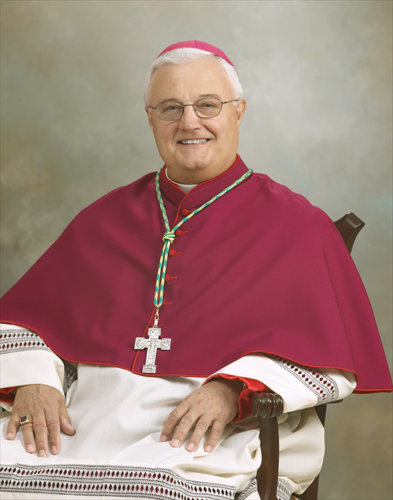
+Joseph Nunzio was a second generation American whose four grandparents emigrated to New Orleans from a small town on the central plains of Sicily known as Contessa Entellina. In New Orleans, most Sicilian heritage citizens come from Contessa.
Contessa is part of the Eparchy of Piana degli Albanesi, which serves the descendants of the Albanians who came to Sicily in the 1500s after holding off the Ottoman’s. The pope gave them five towns in Sicily. Albanians are Roman Rite and Byzantine Rite Catholics. +Joseph Nunzio’s father was Roman Rite, hence the name Latino; his mother’s family was Byzantine Rite (Italo-Albanesi). He had a cousin who was a Byzantine Rite priest named Papas Mateo Sciambra, who taught music in the seminary in Palermo.
In 2012, +Joseph Nunzio was finally able to visit his ancestral home and meet many Sciambra cousins in Contessa. New Orleans descendants formed the Contessa Entellina Society to celebrate their proud heritage. To our knowledge, +Joseph Nunzio was the only man to receive the Society’s Man-of-the-Year Award twice.
Since this week’s paper is a digital edition only, I thought I would share some images of him that give a small glimpse into his life of service to the Lord as a priest, bishop and faithful servant. There are far too many to share…
(Mary Woodward is Chancellor and Archivist for the Diocese of Jackson.)
more about Bishop Latino:
Bishop Joseph Latino – farewell humble shepherd
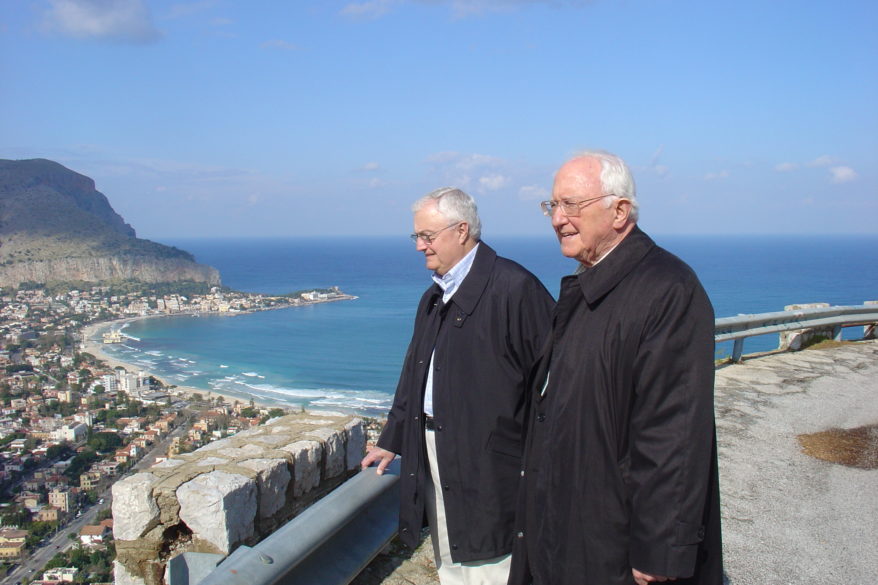
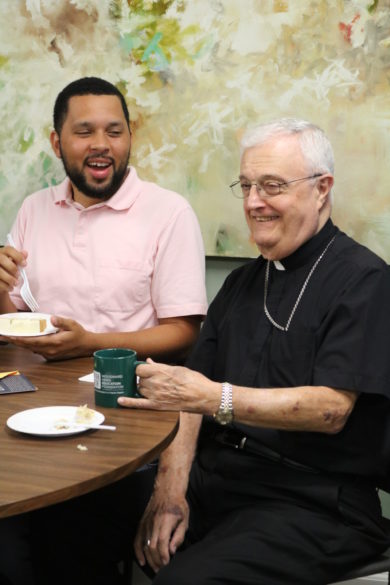
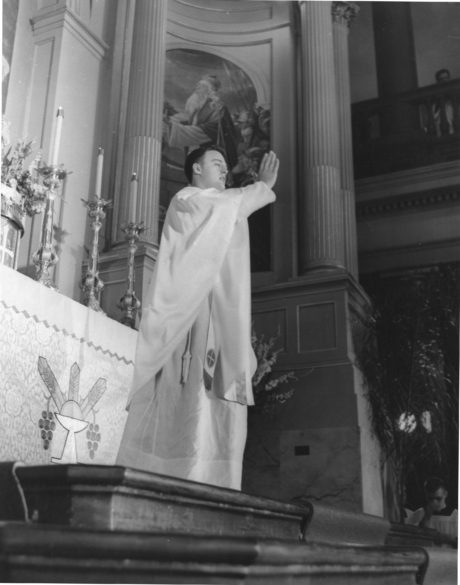
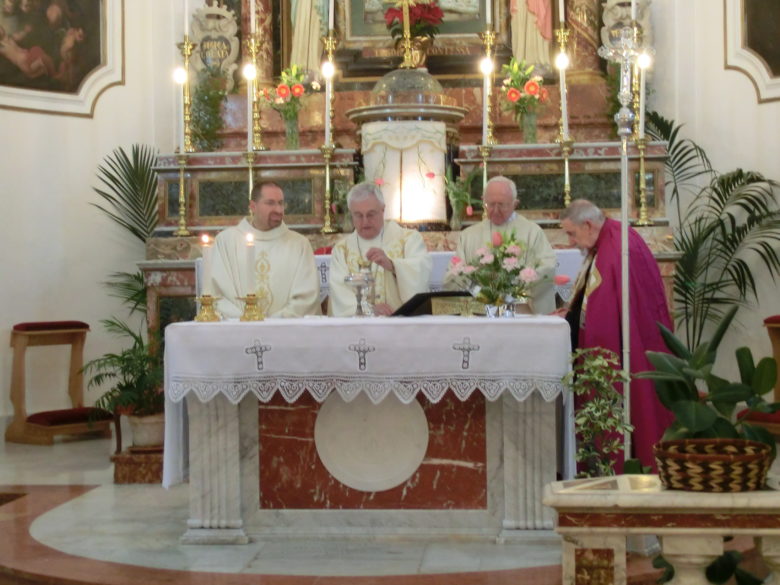
From the top, left to right to bottom: Bishops Latino and Houck look out over Sferracavallo during 2012 visit Latino’s ancestral homeland of Sicily; Chris Luke and Bishop Latino at his 80th birthday celebration at the chancery on Oct. 21, 2017; first Solemn Blessing concluding his first Mass on May 26, 1963; Father George, Bishop Latino, Bishops William Houck and Sotir Ferrara, during a visit to Italy in 2012.(Photos courtesy of archives)
From the Archives
By Mary Woodward
JACKSON – In this installment from the archives, I would like to do two commercials.
First, October is American Archives Awareness Month. Archive collections around the country feature treasures of historical documents, artifacts and visual images. More and more, digital-born images are becoming common place inhabitants of archive collections. This is creating new and challenging ways to manage our collective memory.
The Gulf South region of the United States loves its history and that is reflected in those states attention to maintaining archives. I am proud to say that the State of Mississippi has one of the finest archives in the entire country. Alabama and Louisiana have fine systems as well.
Mississippi State University is home to the papers of President and General Ulysses S. Grant; the University of Southern Mississippi has an excellent library and information science program that trains future archivists. The archives at Ole Miss house a fantastic blues collection along with the “Rowan Oaks” papers of William Faulkner and papers of many other Mississippi authors.
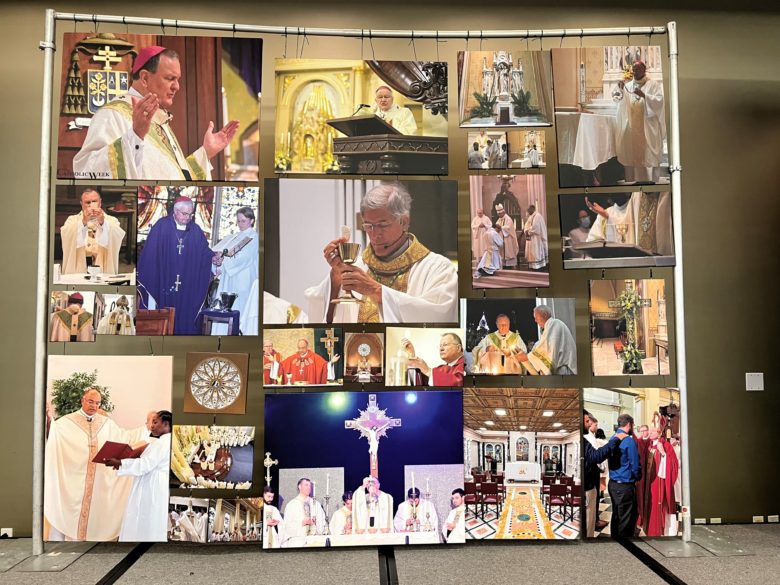
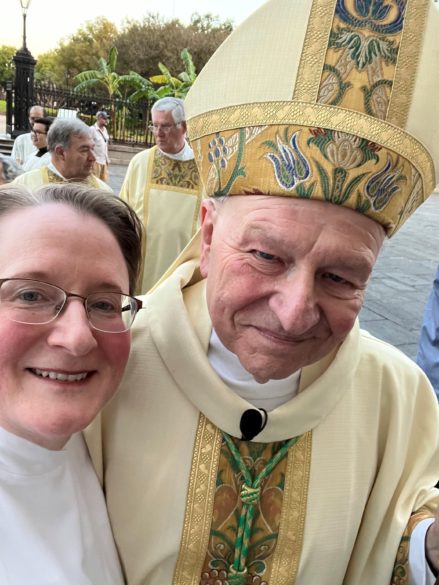
In terms of Catholic archives, our diocesan archives could be considered a national treasure because of its content dating back to Spanish Colonial times. Our documents on the Civil Rights Movement give witness to the church’s involvement in the struggle for justice during those most turbulent times.
Having visited the archives of the Archdioceses of Mobile and New Orleans, both have similar collections to ours spread throughout entire floors of buildings. The three collections put together capture the history and development of the region through the unique lens of the church dating back to the 17th century.
Archives are repositories of history, kept in a way that reveal history as it was and not as we think it was. Archives prevent us from being nostalgic and seeing the “good ole days” through the proverbial rose-colored glasses. Archives are living, breathing, organic insights into the soul of a community illuminating human nature in its most honest state. I like to call it the Kingdom of Memory.
What we do not often think about is each one of us is a walking archive collection. We keep family photos, birthday cards, love letters, diaries, etc., in our collections. Some of us have drawers neatly organized with our archive while others have refrigerators covered with a collection held together by eclectic magnets. But more importantly our hearts, minds and souls are filled with recollections and even scars of a lifetime. Each moment carefully tucked away in the repository of the kingdom of memory.
The second commercial is for the Diocesan Eucharistic Revival event being held Oct. 28-29, at St. Joseph Church in Gluckstadt. The U.S. bishops conference has created a three-year national Eucharistic Revival journey that began this past Corpus Christi and will culminate with a National Eucharistic Congress in Indianapolis in 2024.
Our diocesan event will include prayer, adoration, opportunities for the sacrament of penance, and conclude with the celebration of the Eucharist with Bishop Joseph Kopacz. This Eucharistic renewal journey naturally flows out of a desire by all of us to deepen our ongoing understanding of the Eucharist.
This past week, I participated in the national gathering of the Federation of Diocesan Liturgical Commissions, FDLC, which is a partner entity of the U.S. bishop’s conference engaged in formation of laity and clergy in fully implementing Sacrosanctum Concilium, the Constitution on the Sacred Liturgy.
Our region hosted the gathering in New Orleans and the theme was “Ars Celebrandi: Something More is Required,” which is taken from paragraph 11 of the Constitution. Ars celebrandi is simply translated as the art of celebrating.
The full paragraph is worth noting here: But in order that the liturgy may be able to produce its full effects, it is necessary that the faithful come to it with proper dispositions, that their minds should be attuned to their voices, and that they should cooperate with divine grace lest they receive it in vain. Pastors of souls must therefore realize that, when the liturgy is celebrated, something more is required than the mere observation of the laws governing valid and licit celebration; it is their duty also to ensure that the faithful take part fully aware of what they are doing, actively engaged in the rite, and enriched by its effects.
As part of the environment committee, we created a mosaic of ars celebrandi moments in liturgy featuring our region’s metropolitan archbishops and our own Bishop Kopacz. A highlight of the conference for me was to be able to serve Mass in St. Louis Cathedral as the miter bearer for Archbishop Gregory Aymond. I am grateful for this honor and will certainly file it in my kingdom of memory.
During the Mass in the cathedral, I reflected on paragraph 11 and how much more is required of all of us in understanding the great gift of the Eucharist. Do we really understand the communal nature of worship and the importance of the postures and actions of liturgy as the Body of Christ? Do we know what actually is happening in the sacred mysteries when heaven and earth meet on the altar?
Throughout the next two years in tandem with our synodal encounter journey, we will strive to offer “something more” in an effort to profoundly increase our understanding of these questions. Please join us Oct. 28-29 in Gluckstadt and if you are not able to be there physically for this inspiring event, join us through prayer.
(Mary Woodward is Chancellor and Archivist for the Diocese of Jackson.)
From the Archives
By Mary Woodward
JACKSON – In the last episode we had travelled with Bishop Gunn out West for a series of retreats. He had just arrived in Seattle on Aug. 14, 1918 and found himself with a week before his next engagement.
Seizing a few days off, he left Seattle and made his way across the border to British Columbia in Canada. Bishop Gunn had visited this part of the world before and he comments on its progress, although he makes a very “Gunnian” comment about war rations and the inhabitants of this British province.
“I left Seattle and went up the Puget Sound and spent a few days in Victoria and British Columbia. This was during the hottest part of the war when the Americas were eating stale bread, doing without sugar, sparing of everything and it was strange to find in the British Dominion that restrictions were unheard of. We were starving ourselves for the British and they were growing fat on our service and sacrifice.”
Wow. Bishop Gunn’s candor and wit are priceless moments of discovery. The journey continues below:
“I had been in Victoria and British Columbia years before, but the change and the betterment of both places was a distinct surprise. The trip on the Sound was ideal and when I got back to Seattle I was sorry to leave it.
“Seattle had grown from 20,000 to 600,000 between my two visits although there was not more than ten or fifteen years between the two. I had stopped in a little wooden frame hotel called the Washington. I looked for the same place in 1918 to find a hotel almost as big as the Waldorf-Astoria of New York.
“I enjoyed the week’s rest and left Sunday the 18th for Portland where I was booked to preach the retreat for the Archdiocese from the 19th to the 23rd. Archbishop Christie received me like a prince. I was comfortably installed in the Holy Cross College known as Columbia University and I found the priests attentive and respectful.
“There were about 85 in attendance. I gathered that the men would rather talk then mediate and it was like squeezing blood out of a turnip to me to give six original talks each day. However, I did it and they enjoyed it.
“At the close of the retreat, we had a big dinner at the Archbishop’s house and I was surprised to meet there Mgr. Kelley of [Catholic] Extension and Chas. Denechaud of New Orleans. After dinner we took a drive on probably the finest highway in America – the famous Oregon Highway which runs along the Dalles for fifty or sixty miles and affords scenery which cannot be duplicated anywhere.
“I left Portland for Helena arriving there on August 26th to begin a retreat which ended on the seventh anniversary of my consecration, August 29th.
“There were about eighty priests present and there was more formality in Helena than in St. Paul’s, St. Cloud or in Portland. The bishop, Bishop Carroll, assisted from the throne vested in all his glad rags.
“I tried some heavy stuff on the first day, but I found that the priests were human like everybody else and I switched to things practical and pastoral, with the result that we had really a very interested, I was told, and enthusiastic retreat.
“On Thursday a surprise, and frankly a very welcome one, came to me. The bishop was all apologies and told me that he was up against it – that some state law had come into effect on which all the priests had to take immediate action in view of getting St. Charles’ College accredited as a war college during the period of the war.
“The bishop said it was vital to the diocese that the priests should all hurry home and get busy pulling political strings on Friday and Saturday and make college announcements on the following Sunday. I yielded with internal joy and external resignation.
“The bishop asked me to give a closing lecture on education and as a talk like that needed no preparation on my part, I satisfied the bishop and primed the priests for their work, especially on the following Sunday. The result of their action was that St. Charles got the appointment.
“On Thursday night I left with the priests and many of them came as far as Butte and among them was an ex-Marist who was pastor of one of the Butte churches. I had taught this man in Washington in 1892. He was a little scatter brained and his assignment to Salt Lake College gave him wanderlust and he managed to get identified with the Diocese of Helena. He was a good fellow and I really enjoyed him.
“I got away from Butte on the night of August 29th and spent the two remaining days of August on the train. On September 1st I arrived in Chicago where I ran into a well-organized strike. This strike was among the cabmen, taxi drivers and streetcar men and I found myself at the railroad station and no means to get myself to a hotel.
“The strike was thorough and not a wheel could be turned in Chicago for money. I was in such a pickle that I threw timidity to the winds and asked a gentleman who was driving a private auto to take me to my hotel.
“I was in a city of churches on Sunday, September 1st and I could not find a Catholic Church in Chicago, with the result that I neither said Mass nor heard Mass – a nice example of a man who had been preaching retreats to priests for about a month.”
This concludes our world wind 1918 summer journey across the continent with Bishop Gunn. I hope it gives us a better understanding of and appreciation for our early church leaders in this country. Quite the time…
(Mary Woodward is Chancellor and Archivist for the Diocese of Jackson.)
From the Archives
By Mary Woodward
JACKSON – In these From the Archives articles I have chronicled a lot about Bishop John Edward Gunn, SM, sixth bishop of our diocese. In this installment I would like to bring to light that Bishop Gunn was a highly sought-after retreat master. Bishops around the country would recruit him to give retreats to the clergy of their diocese.
Therefore, here is a description of his journeys across the country by train in August of 1918. World War I was still raging, and forest fires had been ravaging the western United States. It sounds vaguely familiar in some respects, but also gives a unique view of the development of the Northwest.
“On August 1st I went to Vicksburg where I remained a few hours, taking the night train to Memphis from there. I got the Chicago train at six twenty, reaching the Auditorium on August 2nd. There I heard of the birth of Roy McCanna’s baby – long expected, much prayed for and the most welcome youngster that ever appeared in Wisconsin. I phoned my congratulations from Chicago, and I was requested to stop over on my way to St. Paul to baptize the youngster, which I did on Saturday, August 3rd.
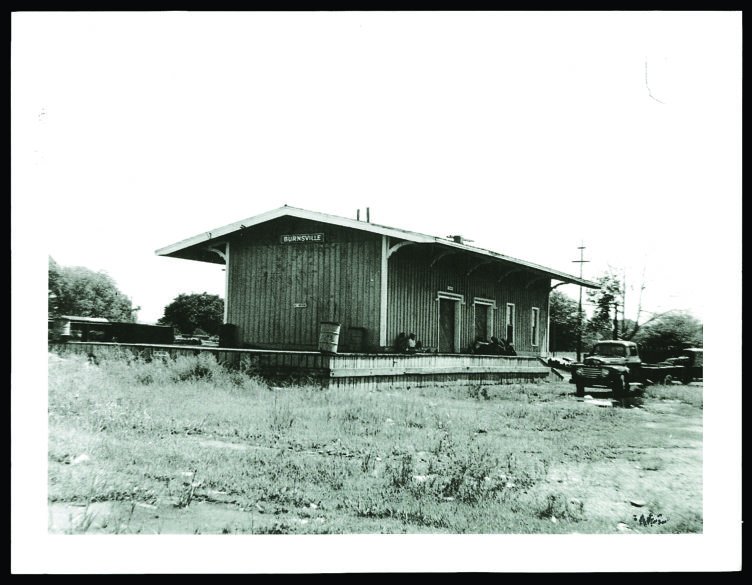
“I left the same night for St. Paul’s and reached the Marists on Sunday, August 4th. I called to see Archbishop Ireland and found him in a dying condition in his new home on Summit Avenue. The Catholics of St. Paul had purchased the finest house in the city and donated it to the Archbishop. He was brought into it, put to bed and he actually never saw the house that was his own.
“I left for St. Cloud on August 5th and went to St. John’s College, the Benedictine Monastery, where I was booked to preach a retreat for the clergy of the Diocese of St. Cloud. I started in on Monday and ended on the following Friday. Bishop Busch of St. Cloud was persuaded by Archbishop Ireland to get me to give the retreat, owing to war conditions which were painfully acute in that section of Minnesota.
“Practically all the Priests and nearly 90% of the Catholics of St. Cloud were pro-German. The Bishop, of German Extraction, was very American and this created a natural state of war or at least of ill-feeling between the Catholics and the Bishop. I was supposed to smooth things out and while the Priests resented a retreat in English, one of the first every given in that language in the diocese, still they treated me very well.
“St. John’s College was a place worth seeing. The community was very large, the Monastery grounds covered 1000 acres, the monks were farmers as well as priests and the place was as near ideal as could possibly be imagined.
“There was a lake in the center of the property which was so thickly stocked with fish that it was almost a crime to throw in a hook and line. It was not fishing – it was slaughter.
“I left St. Cloud satisfied with myself and I think left the Bishop and his priests pretty well satisfied and came to St. Paul where I stopped at the Ryan Hotel. I spent the night of August 10th with the Marists on Cedar Street and helped them out on Sunday and left Sunday night over the Chicago, Milwaukee & St. Paul for Seattle.
“On the train, I met Archbishop Messmer of Milwaukee, and we exchanged a lot of thought between Milwaukee and Spokane. The Archbishop had put his parish church under interdict and excommunicated three or four Polish priests on the day on which we met, so I think he was looking for shelter.
“The trip from St. Paul to Seattle was over some of the wildest parts of America. There was not a town of any importance after leaving Minneapolis. The Rockies were not as wild further South.
“The one thing that was a novelty to me was to go through a country that had been a raging furnace for over two years and a half and defied the power of the United States to put out the forest fires. The country showed the ruins of fire and looked as sad a spectacle as could be imagined.
“On the trip, I saw for the first time a railroad actually controlled and propelled by electricity. The big Mountain engines could not do the work and tremendous electric power houses were installed all along the line and engines equipped to suit. We zig-zagged around the Mountain and took a day to travel a bee line distance of thirty or forty miles. The trip was pleasant as we reached Seattle on August 14th.”
In my opinion, bishops are not always appreciated until years after their tenure. Bishop Gunn certainly had his moments during his time in office that caused consternation among clergy and faithful, but we are very fortunate to have his diary to share his adventures in the early 1900’s from his unique perspective. Now, more than 100 years later time sheds light on the wisdom of his actions.
In our next installment, we will continue this journey with Bishop Gunn as he shares his keen wit and intellect across the country.
(Mary Woodward is Chancellor and Archivist for the Diocese of Jackson.)
From the Archives
By Mary Woodward
JACKSON – In Mississippi, the month of August stirs a myriad of thoughts of the “3-H’s” for which we are so well-known – heat, humidity and hurricanes. This August is no different. I would like to share a couple of memories of Augusts gone by.
Two of the worst hurricanes to make landfall in the history of the state and country were August hurricanes named Camille (Aug. 17 and 18, 1969) and Katrina, which actually made landfall first across Miami on Aug. 23, 2005, then again in Mississippi on Aug. 29.
Well, let me now date myself. I remember Hurricane Camille. We grew up on Millsaps College campus in Jackson in faculty housing. When Camille came ashore 170 miles south of our house, the old-style metal two-inch green Venetian blinds stood out from the windows rattling in the wind all night long. That image is forever etched in my mind.
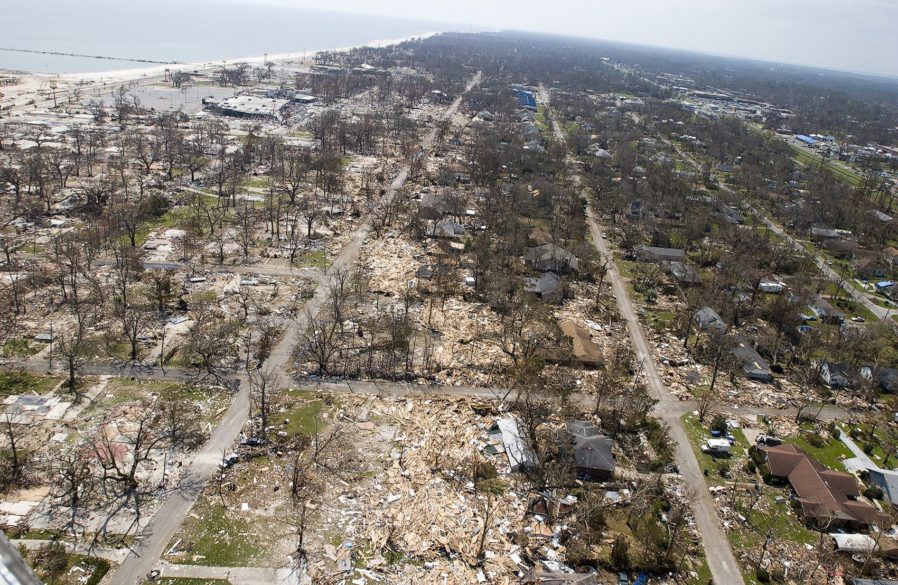
Prior to destroying all wind measuring tools, Camille was clocked at a one minute sustained 175 mph winds with a 25-foot storm surge. She was fierce and became the benchmark of storms for years to come until 2005, when Katrina made her way toward the Gulf Coast.
What many may not remember is Katrina had already made landfall near Miami and caused widespread flooding and power outages there a week before. I remember because Bishop Joseph Latino was in Miami when the first landfall occurred. He had that kind of luck throughout his life.
As I watched the path of Katrina develop, it became eerily similar to Camille’s path straight up the Gulf. When I picked up Bishop Latino at the airport upon his return from Miami a few days after the initial landfall, I made the remark that Katrina was following him. There was definitely a bad feeling about this storm.
That weekend, the Cathedral in Jackson experienced standing room only congregations – filled with evacuees from the Gulf Coast and Louisiana. As people came forward in the communion line, there was not a dry eye in the house.
While Katrina was making landfall early Monday morning, we in the chancery office were sent home and told to be where we needed to be for the next 12 hours by 11 a.m. When I arrived home after dropping off a couple of cases of Catholic Extension Bibles for evacuees at the Coliseum, I hunkered down with my pimento cheese and Zapp’s. Taking comfort in the fact that my 70-year-old house had survived Camille, I watched the news until the power was knocked out around noon.
Still, I was confident in the structure of my house even when the attic turbine snapped off, bounded down the roof and landed at my feet on the back porch. I was losing confidence when I took my nearly decapitated self into the attic to put a bucket under the hole in the roof left by the now absent turbine. I recall thinking “next stop Oz.”
After what seemed like a 10-hour tornado in slow motion, the next morning I ventured out following the sounds of the chainsaw to get neighbors to put me on their list of tree removal. They came and dispatched the tree on the fence, shared some cold water I had in an ice chest (I was prepared because of the really bad feeling about the storm), and moved on to the next neighbor.
We all pulled together to help because we knew if it was this bad in Jackson, it had to be 1000 times worse on the Coast. I recollect seeing the helicopter flyover of the Gulf Coast – we were wrong – it was a million times worse. Who could have ever imagined worse devastation than Camille? Those thoughts entered my mind in the attic the night before, but the reality of it in one flyover report removed all doubt.
After a day of clean up in the neighborhood, the next day provided a chancery office with electricity and air-conditioning. It also became a hub for evacuees to come and use email and Facebook on our computers to let family and friends around the world know they were ok.
Indeed, it was quite the time in Jackson, but nothing in comparison to our friends at the chancery office in Biloxi whom we did not know whether they were ok or not for a full two days due to shattered communication lines and towers.
From an archive’s perspective, after dealing with the humanitarian needs of these disasters, thoughts turn immediately to sacramental registers in destroyed churches. These registers contain our sacramental lives, which are often used to establish identity, get a passport and obtain pensions. In our diocese, every 10 years we bring in these registers and make copies of the contents in the event of such a disaster.
Because there were microfilm copies of registers in 1969, parishes that may have lost registers to the storm were able to get copies of them. Ideally, these registers would be stored in secure environments, but that is not always possible.
As we move through August and the Gulf continues to heat up, this is a prime time for parishes to reexamine plans for sacramental register safekeeping. Simple things such as large Ziploc bags on hand and portable watertight containers available can go a long way in protecting these lifelines for parishioners and the church.
Another handy thing to have is a disaster clean up kit in a bucket that includes bleach, gloves, masks and scrubbing brushes. As I write this, I remember there is a bucket is still in my attic… Take care and stay safe.
(Mary Woodward is Chancellor and Archivist for the Diocese of Jackson.)